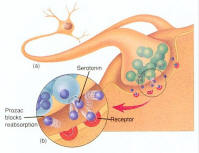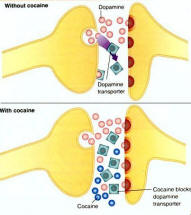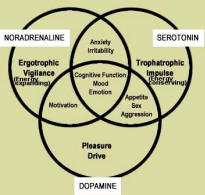|
Information
on
neurotransmitters
CIDPUSA Foundation | | |
alternatives treatment of autoimmune disease read our e-book
 |
Manipulations and abuses. Natural neuromodulators can aid the release or inhibit the
reabsorption of neurotransmitters; still others delay the
breakdown after reabsorption, leaving them in the tip to be
reused by the next nerve impulse. Mood, pleasure, pain, and
other mental states are determined by particular groups of
neurons in the brain that use special sets of
neurotransmitters and neuromodulators. For example, mood is
strongly influenced by the neurotransmitter serotonin. It is
believed that depression results from a shortage of
serotonin. It is difficult to treat depression directly with
serotonin because the chemical has too many other side
effects. However, depression can be successfully treated
with drugs that act as serotornin neuromodulators (Figure
02d). Prozac, the |
|
|
world's top-selling antidepressant, inhibits
the reabsorption of serotonin, increasing the amount in the
synapse by slowing down its removal.
|
 |
When a neuron cell is exposed to a
neurotransmitter for a prolonged period, it tends to lose
its ability to respond to the stimulus with its original
intensity. This is known as habituation, which is the result
of the cell producing fewer receptors for that particular
neurotransmitter. If someone takes a drug that acts as a
neuromodulator (such as cocaine), which causes abnormally
large amounts of neurotransmitter (dopamine in this case,
Figure 02e) to remain in the synapses for long periods of
time, it would generate more pleasure messages. Such action
reduces the number of receptors in the neuron. Next time a
higher dosage is required to maintain the pleasurable
sensation. The result is addiction. Cocaine is a stimulant
discovered in the mid-1800s. Many physicians at first
considered it a miracle drug, prescribing it for all sorts
of physical and mental ailments; it was even added to soft
drinks. Today United States law forbids the importation,
manufacture, and use of cocaine for nonmedical purposes, and
even the medical use is extremely limited. |
|
|
|
 |
Neurotransmitters can be broadly classified
into two groups - the "classical", small molecule
neurotransmitters and the relatively larger neuropeptide
neurotransmitters. The small molecule types are mainly
amino acids and amines (a nitrogen atom bonds to a
maximum of three hydrocarbon groups). The larger
neurotransmitters are combination of two or more amino acids
joined by peptide bonds. Some fifty different
neurotransmitters have been identified. The form of
receptors for the neurotransmitters varies depending on the
location in the body and produces different physiologic
symptom. Understanding the numerous neurotransmitters, their
receptors, locations and interactions with one another has
been central to the design of medicines for mental illness.
Figure 02f shows the effects of three major
neurotransmitters and the mental states induced by their
interactions.
Table 01 summarizes the properties of some important
neurotransmitters. |
Figure 02f Types of Neuro-transmitter
[view large image]
|
|
| Name |
Type |
Postsynaptic Effect |
Location(s) |
Function(s) |
|
Dopamine |
Amine |
Excitatory |
Brain, smooth muscle |
Control arousal levels |
|
Serotonin |
Amine |
Excitatory |
Brain, smooth muscle |
Effects on mood, sleep, pain, appetite |
|
Noradrenaline |
Amine |
Excitatory |
Brain, smooth muscle |
Induce arousal, heighten mood |
|
Acetylcholine (ACh) |
Acetic acid |
Excitatory & Inhibitory |
Parasymathetic nervous system, brainstem |
Role in memory, vasodilation |
| GABA§ |
amino acid |
Inhibitory |
Brain |
Control anxiety level |
|
Enkephalin (opiate) |
Neuropeptide |
Inhibitory |
Brain, spinal cord |
Reduce stress, promote calm, natural painkiller |
Table 01 Neurotransmitters
§GABA stands for gamma aminobutyric acid, which is
synthesized from
glutamate
by organisms.
[Top]
Continue to Brain page |
|
|
|
|
|
|
|
| |
|